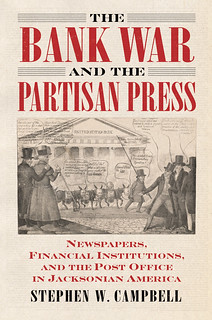
PREV ARTICLE
NEXT ARTICLE
FULL ISSUE
PREV FULL ISSUE
NEW BOOK: THE BANK WAR AND THE PARTISAN PRESSBernie von NotHaus is far from the first to debate the merits of a central banking system in the U.S. The Winter 2020 issue of Financial History (the magazine of the Museum of American Finance) published an article on a new book that banking and currency mavens may find of interest about the bitter partisan fight over the Bank of the United States. Here's an excerpt. -Editor
Stephen W. Campbell
Readers who appreciate a new interpretation of a familiar event in America's financial history will welcome The Bank War and the Partisan Press. As noted in the subtitle, Stephen W. Campbell's deeply researched work illuminates the role of newspapers, financial institutions and the US Post Office in the argument over the continued existence of the Second Bank of the United States (BUS). No author can dispute the outcome of the struggle between President Andrew Jackson and BUS President Nicholas Biddle. But this one views their dueling statements and actions through a different lens than those who have focused only on the differences between those two stubborn men. He supplements the traditional version of the story by delving into each man's use of emerging national institutions to communicate his points of view. Using some unusual aspects of newspapers and the post office, each was able to spread his arguments in favor of— or in opposition to—the re-charter of the BUS to readers and voters across the country. Campbell believes that gaining a better understanding of this "Second Bank War" will enhance our knowledge about both this classic struggle and the widespread contemporaneous conflicts between people with differing views of the government's role in the financial system. The author devotes a good percentage of his narrative to examinations of both newspapers and the post office in the 1830s. Privately financed newspapers relied on subscriptions and advertising for much of their revenue. Campbell describes how most of them also depended on federal subsidies to make ends meet. Much of that funding consisted of printing contracts from Congress and a variety of executive department agencies. He also tells how the post office provided newspapers with additional funding. This help took the form of advertisements describing the creation of new postal routes, the extension of the franking privilege to members of Congress, subsidized costs for delivering newspapers and the free exchange of published articles among editors in various locations. That government agency also granted lucrative mail delivery contracts to favored editors and even appointed some of them as postmasters. Reading that history enables the reader to appreciate more fully Campbell's story of two newspapers that spent much of 1831–1833 endorsing and communicating the arguments against (the Globe) and in support of (the National Intelligencer) the continued existence of the BUS. He presents those papers' interactions with Jackson and Biddle as examples of the intermingling of public and private interests in fostering arrangements that benefitted all parties. Many editors were currying favor with politicians whose ideas they favored; and many politicians responded by enhancing the business opportunities available to those supportive editors. For more information on the Museum of American Finance, see:
For more information, or to order, see:
Wayne Homren, Editor The Numismatic Bibliomania Society is a non-profit organization promoting numismatic literature. See our web site at coinbooks.org. To submit items for publication in The E-Sylum, write to the Editor at this address: whomren@gmail.com To subscribe go to: https://my.binhost.com/lists/listinfo/esylum All Rights Reserved. NBS Home Page Contact the NBS webmaster 
|
